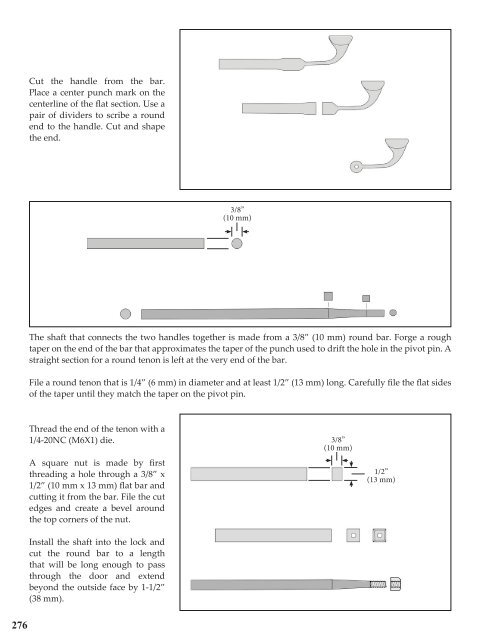The New Spruce Forge Manual of Locksmithing: A Blacksmith’s Guide to Simple Lock Mechanisms
The New Spruce Forge Manual of Locksmithing: a Blacksmith’s Guide to Simple Lock Mechanisms is a totally revised and expanded version of the original work from 1999. This new hardcover edition, at 304 pages and with more than 800 color photos and illustrations, is more than double the size of the original manual. It is divided into two distinct sections: Technical Information - This section is a reference manual in itself that covers the specific tools and techniques needed to build all the parts for each lock, as well as providing the information needed to understand the assembly instructions outlined in the second section. The Locks: Patterns & Instructions - This section provides the plans and detailed instructions for each of the 14 lock projects in this new edition. The clear assembly instructions describe when and how to use the technical information provided in section one. The authors have maintained their original trademark style that relies on well-illustrated step-by-step instructions that guide you through the whole lock-making process. They have also kept their low-tech approach that demonstrates how to go about creating good work using only a handful of simple tools. Making blacksmith locks is an age-old skill the authors of this manual are helping to preserve by passing on their knowledge to this book’s readers. The New Spruce Forge Manual of Locksmithing is also an excellent introduction to benchwork, which is a useful skill for any blacksmith to acquire. This manual will become a valuable, trusted and often referred to sourcebook in your blacksmithing library. Hardcover, 304 pages, more than 800 photos and illustrations.
The New Spruce Forge Manual of Locksmithing: a Blacksmith’s Guide to Simple Lock Mechanisms is a totally revised and expanded version of the original work from 1999. This new hardcover edition, at 304 pages and with more than 800 color photos and illustrations, is more than double the size of the original manual.
It is divided into two distinct sections:
Technical Information - This section is a reference manual in itself that covers the specific tools and techniques needed to build all the parts for each lock, as well as providing the information needed to understand the assembly instructions outlined in the second section.
The Locks: Patterns & Instructions - This section provides the plans and detailed instructions for each of the 14 lock projects in this new edition. The clear assembly instructions describe when and how to use the technical information provided in section one.
The authors have maintained their original trademark style that relies on well-illustrated step-by-step instructions that guide you through the whole lock-making process. They have also kept their low-tech approach that demonstrates how to go about creating good work using only a handful of simple tools.
Making blacksmith locks is an age-old skill the authors of this manual are helping to preserve by passing on their knowledge to this book’s readers. The New Spruce Forge Manual of Locksmithing is also an excellent introduction to benchwork, which is a useful skill for any blacksmith to acquire. This manual will become a valuable, trusted and often referred to sourcebook in your blacksmithing library.
Hardcover, 304 pages, more than 800 photos and illustrations.
You also want an ePaper? Increase the reach of your titles
YUMPU automatically turns print PDFs into web optimized ePapers that Google loves.
Cut the handle from the bar.<br />
Place a center punch mark on the<br />
centerline <strong>of</strong> the flat section. Use a<br />
pair <strong>of</strong> dividers <strong>to</strong> scribe a round<br />
end <strong>to</strong> the handle. Cut and shape<br />
the end.<br />
3/8”<br />
(10 mm)<br />
<strong>The</strong> shaft that connects the two handles <strong>to</strong>gether is made from a 3/8” (10 mm) round bar. <strong>Forge</strong> a rough<br />
taper on the end <strong>of</strong> the bar that approximates the taper <strong>of</strong> the punch used <strong>to</strong> drift the hole in the pivot pin. A<br />
straight section for a round tenon is left at the very end <strong>of</strong> the bar.<br />
File a round tenon that is 1/4” (6 mm) in diameter and at least 1/2” (13 mm) long. Carefully file the flat sides<br />
<strong>of</strong> the taper until they match the taper on the pivot pin.<br />
Thread the end <strong>of</strong> the tenon with a<br />
1/4-20NC (M6X1) die.<br />
A square nut is made by first<br />
threading a hole through a 3/8” x<br />
1/2” (10 mm x 13 mm) flat bar and<br />
cutting it from the bar. File the cut<br />
edges and create a bevel around<br />
the <strong>to</strong>p corners <strong>of</strong> the nut.<br />
Install the shaft in<strong>to</strong> the lock and<br />
cut the round bar <strong>to</strong> a length<br />
that will be long enough <strong>to</strong> pass<br />
through the door and extend<br />
beyond the outside face by 1-1/2”<br />
(38 mm).<br />
3/8”<br />
(10 mm)<br />
1/2”<br />
(13 mm)<br />
276










